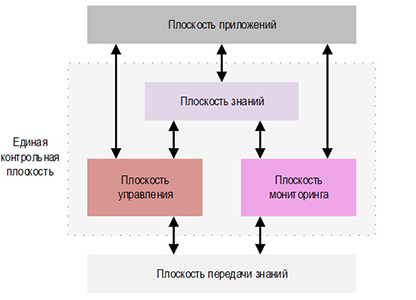
Future Architecture of Knowledge-Defined Networking (KDN)
https://doi.org/10.31854/1813-324X-2025-11-2-67-82
EDN: QCIUMV
Abstract
In this paper, the concept and architecture of Knowledge-Defined Networking (KDN) are explored as a new paradigm of network management that integrates artificial intelligence and machine learning to enable intelligent and adaptive network behavior.
The relevance of the research is driven by the limitations of traditional and Software-Defined Networking (SDN) systems in the face of modern challenges such as exponential traffic growth, dynamic conditions, and rising operational costs. KDN introduces a knowledge plane that optimizes resource allocation, automates decision-making, and enhances security in real-time. Despite the fact that today the SDN (Software-Defined Network) technology is very popular, in which the centralized control function allows to review all processes occurring in the network. At the time, its appearance really turned out to be a breakthrough, and now some experts are inclined to believe that the next stage of network evolution will be the Knowledge-Defined Network - a network defined by knowledge, operating on the basis of machine learning algorithms. Routing, resource allocation, network function virtualization (NFV), service function chaining (Service Function Chaining, SFC), anomaly detection, network load analysis - all these points can be taken on by KDN. The study aims to examine the structural and functional features of KDN and analyze the interaction of its five logical planes ‒ data, control, monitoring, knowledge, and applications ‒ to achieve a high degree of automation and adaptability.The research methods include literature analysis, conceptual modeling, and a comparative evaluation of KDN and SDN architectures.
The results. The study analyzed the architecture of KDN, comprising five logical planes: data, control, monitoring, knowledge, and applications. The findings demonstrate that integrating the knowledge plane significantly enhances automation and adaptability within the network.
The novelty of this work lies in being one of the first attempts to conduct a systematic analysis of the Knowledge-Defined Networking (KDN) concept in the context of Russian-language scientific literature. The research addresses an existing gap in domestic science, offering a unique perspective on KDN capabilities considering local conditions and applications.
The theoretical significance of the work lies in establishing a foundation for the study and integration of machine learning methods into network management systems.
About the Authors
F. S. BlanRussian Federation
V. S. Elagin
Russian Federation
References
1. Zoraida B.S.E., Ganesan I. A Comparative Study on Software-Defined Network with Traditional Networks. TEM Journal. 2024;13(1):167–76. DOI:10.18421/TEM131-17
2. Hakiri A., Gokhale A., Berthou P., Schmidt D.C., Gayraud T. Software-defined Networking: Challenges and Research Opportunities for Future Internet. Computer Networks. 2014;75(A):453–71. DOI:10.1016/j.comnet.2014.10.015
3. Ashtari S., Zhou I., Abolhasan M., Shariati N., Lipman J., Ni W. Knowledge-defined networking: Applications, challenges and future work. Array. 2022;14:100136. DOI:10.1016/j.array.2022.100136
4. Jarrahi M.H., Askay D., Eshraghi A., Smith P. Artificial intelligence and knowledge management: A partnership between human and AI. Business Horizons. 2023;66(1):87–99. DOI:10.1016/j.bushor.2022.03.002
5. Srinivas T.A., Donald A., Thippanna G., Kousar M., Priya A. From Control to Chaos: The Dynamic SDN Control Plane. International Journal of Advanced Research in Science, Communication and Technology. 2023;3(2):494–502. DOI:10.48175/IJARSCT-8527
6. Mestres A., Rodriguez-Natal A., Carner J., Barlet-Ros P., Alarcón E., Solé-Simó M., et al. Knowledge-Defined Networking. ACM SIGCOMM Computer Communication Review. 2017;47(3):2–10. DOI:10.1145/3138808.3138810
7. Li W. Explore the Evolution of Computer Network Architecture. International Journal of Religion. 2024;5(11):9034–9054. DOI:10.61707/ahr2da31
8. Das R., Pohrmen F., Maji A., Saha G. FT-SDN: A Fault-Tolerant Distributed Architecture for Software Defined Network. Wireless Personal Communications. 2020;114:1045–66. DOI:10.1007/s11277-020-07407-x
9. Wang T., Su Z., Hamdi M. Rethinking the Data Center Networking: Architecture, Network Protocols, and Resource Sharing. IEEE Access. 2014;2:1481–96. DOI:10.1109/ACCESS.2014.2383439
10. Agoulmine N. Chapter 1. Introduction to Autonomic Concepts Applied to Future Self-Managed Networks. In: Walsh S.M., Strano M.S. (ed.) Autonomic Network Management Principles. Academic Press; 2011. p.1–26. DOI:10.1016/B978-0-12-382190-4.00001-2
11. Silver E. An overview of heuristic solution methods. Journal of the Operational Research Society. 2004;55(9):936–56. DOI:10.1057/palgrave.jors.2601758
12. Oladipupo T. Machine Learning Overview. In: Zhang Y. (ed.) New Advances in Machine Learning. InTech; 2010. p.9–18. DOI:10.5772/9374
13. Nasteski V. An overview of the supervised machine learning methods. Horizons. 2017;4:51–62. DOI:10.20544/ HORIZONS.B.04.1.17.P05
14. Yazici İ., Shayea I., Din J. A survey of applications of artificial intelligence and machine learning in future mobile networks-enabled systems. Engineering Science and Technology, an International Journal. 2023;44:101455. DOI:10.1016/j.jestch.2023.101455
15. Zhang C., Patras P., Haddadi H. Deep Learning in Mobile and Wireless Networking: A Survey. IEEE Communications Surveys & Tutorials. 2019;21(3):2224–87. DOI:10.1109/COMST.2019.2904897
16. Magadum A.A., Ranjan A., Narayan D.G. DeepQoSR: A Deep Reinforcement Learning based QoS-Aware Routing for Software Defined Data Center Networks. Proceedings of the 12th International Conference on Computing Communication and Networking Technologies, ICCCNT, 06‒08 July 2021, Kharagpur, India. IEEE; 2021. DOI:10.1109/ICCCNT51525.2021.9579514
17. Volokyta A., Kogan A., Cherevatenko O., Korenko D., Oboznyi D., Kulakov Y. Traffic Engineering with Specified Quali-ty of Service Parameters in Software-defined Networks. International Journal of Computer Network and Information Security (IJCNIS). 2024;16(5):1–13. DOI:10.5815/ijcnis.2024.05.01
18. Sood M. 5G Network Slicing to Deliver Improved User Experience. International Journal of Computer Trends and Technology. 2023;71(9):59–68. DOI:10.14445/22312803/IJCTT-V71I9P107
19. Yu S., Liu M., Dou W., Liu X., Zhou S. Networking for Big Data: A Survey. IEEE Communications Surveys & Tutorials. 2017;19(1):531–49. DOI:10.1109/COMST.2016.2610963
20. Wen J., Zhang Z., Lan Y., Cui Z., Cai J., Zhang W. A survey on federated learning: challenges and applications. International Journal of Machine Learning & Cybernetics. 2023;14:513–35. DOI:10.1007/s13042-022-01647-y
21. Strannegård C., Häggström O., Wessberg J., Balkenius C. Transparent Neural Networks: Integrating Concept Formation and Reasoning. Proceedings of the 5th International Conference on Artificial General Intelligence, AGI, 8‒11 December 2012, Oxford, UK. Lecture Notes in Computer Science, vol.7716. Berlin, Heidelberg: Springer; 2012. p.302–311. DOI:10.1007/978-3-642-35506-6_31
22. El Boudani B., Dagiuklas T., Iqbal M. SO-KDN: A Self-Organised Knowledge Defined Networks Architecture for Reliable Routing. 2021;160–6. DOI:10.1145/3459955.3460617
Review
For citations:
Blan F.S., Elagin V.S. Future Architecture of Knowledge-Defined Networking (KDN). Proceedings of Telecommunication Universities. 2025;11(2):67-82. (In Russ.) https://doi.org/10.31854/1813-324X-2025-11-2-67-82. EDN: QCIUMV

































